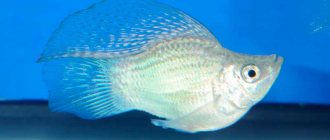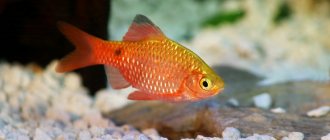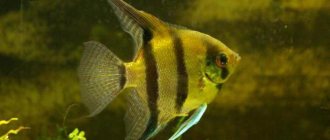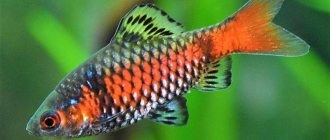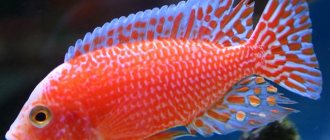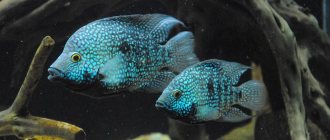Mollies (lat. Mollienesia) are the best choice for beginner aquarists. These fish have many advantages - they are unpretentious, friendly and omnivorous. In the wild, mollies live in fresh and brackish waters of Central America. Wild species are divided into two groups: those with short fins and those with long fins. Fish first appeared in aquariums in 1899. A wide variety of colors, shapes and sizes have been obtained through selective breeding, but three species are most often found in aquariums: Molliesia velifera, Molliesia sphenops and Molliesia latipinas. Hybridization for the purpose of breeding new breeds is still relevant today.
Known species of mollies
Molliesia Velifera. It is distinguished by a well-developed dorsal fan-shaped fin in the male. The body size can reach up to 5 cm. The natural color of the body is silver with horizontal dotted lines, the front part of the body is sometimes painted a pleasant orange color. The tail is turquoise on the periphery and orange in the middle. Females have a grey-green body. The fish is very active and requires a large space for swimming. In its natural environment it feeds on mosquito larvae. Loves slightly salty water.
Molliesia sphenops. It has a dense, elongated and laterally compressed body, a well-developed round fin. Body size: 6-10 cm. The most popular color is pure black. But there are artificially produced white, yellow and speckled ones. The most valuable are considered to be mollies with black velvet scales, whose large black eyes are practically invisible. Sphenops swims preferably in the upper and middle layers of water. They often jump out of aquariums that are not covered with a lid.
Molliesia latipin. It is very similar to the Velifera molly, but is smaller in size. The color is most often bluish-gray. Males are more greenish. The sides are strewn with shiny white dots arranged in rows. The lower part of the body is bright orange.
Description
The aquarium fish mollies belongs to the genus Poeciliidae, which also includes other species popular among beginners, such as swordtails or guppies. If you suddenly know what platies look like in general, then it is possible that you will accidentally consider the mollies to be platies.
Mollies are viviparous creatures and this is one of the main criteria that makes young aquarists become interested in this fish.
As is the case with most inhabitants of domestic ponds, those individuals that live in the aquarium are the fruit of selection work and look much more interesting than their wild companions. So, in the natural environment, mollies are a simple silvery fish, which is sometimes characterized by a yellowish tint, but at home you can see very spectacular black mollies , as well as slightly rarer yellow and speckled individuals . The differences don't end there: species of mollies can have different sizes, not to mention variations in fin shape.
In its natural environment, mollies live off the coast of North and Central America. At the same time, there are officially recognized species (namely species, not breeds) that do not occur in nature and are purely aquarium treasures. Most species of mollies are freshwater, but there are exceptions to this rule.
Significant species diversity affects not only the region where the fish lives and the appearance of the fish, but also how long it can live. The average lifespan of mollies is 4-8 years, while some species that are not found in the wild do not reach such indicators and live a modest 2-3 years. At the same time, the life expectancy of the average female is always slightly higher than that of her friend.
We have already said above that mollies are a diverse fish and should not be perceived as one species. In fact, there are about three dozen species of such fish in nature. These include both those that appeared naturally and those specially bred by man. At home, they often contain the very ones that were born thanks to breeders. Such varieties have a more attractive appearance, and often lack the ability to survive in natural conditions.
To understand what kind of fish you should get to suit your color preferences, let’s look at the names of the most popular species and breeds.
- The peten is a relatively small creature that is often confused with swordtails, since this species also has a characteristic tail extension, although not as large. Peten is characterized by monochromatic mother-of-pearl scales, but on the fins there is a clearly visible identification mark in the form of a red line.
- Free mollies can have different “color schemes,” but almost always their color consists of two colors : the main color is inherent in the body, while the fins are distinguished by increased variegation and beauty. Quite often this fish is found in the following “design”: with a matte black body, its ventral fin has a very bright silver tone.
- The sail mollies got their name from their oversized fins, which, for greater expressiveness, are also emphasized by a border of a characteristic red color. The fish itself cannot be called very bright. The colors of its body can be called typically fishy: gray, silver, bluish and greenish. However, this breed is also distinguished by its impressive size - unlike most of its counterparts, it is capable of growing up to 12-16 cm in length.
- Sphenops is one of the most popular species, which is not surprising, because such a beauty is simply incapable of getting lost in any aquarium. This mollies have an elongated, tightly knit body with small fins. Aquarists are captivated by the deep black color of its body, however, it can have inclusions of other tones, including mainly yellow and silver.
- Snowflake is an artificially bred breed whose appearance fully corresponds to its name, since it is a white fish with a turquoise sheen. A color deviation is allowed on the fins, which can be yellow, but there are also purely white individuals.
- Balloon molly is another artificially bred species that got its name for its specific body shape. You can identify it by its convex belly - absolutely all individuals of this subspecies seem to be pregnant, even if in fact this is not the case.
Representatives of this breed live no more than 3 years, but aquarium connoisseurs love them for their colorful coloring and beautiful fins.
- Dalmatian is another selective breed, whose name does not allow it to be confused with any other fish. This creature has white scales, but a bizarre pattern of black blots is scattered across its entire surface, making the resemblance to the famous dog breed obvious. It is curious that representatives of this species do not have a specific size: an adult can grow up to 12-13 cm, but even 5-6 cm in length is not considered a pathology.
Maintenance and care
As mentioned earlier, due to their simplicity and unpretentiousness, mollies are suitable for keeping by beginning aquarists. They are able to adapt to a wide range of water parameters. But it is still recommended to maintain the most optimal conditions in the aquarium. The water temperature should be 23-28 degrees. Both neutral and slightly acidic water (pH= 7-8) is suitable. They feel great in hard water.
The ideal volume of an aquarium is 50-70 liters, depending on the number of fish living in it. The aquarium must be provided with good filtration and the water must be changed regularly. Fish are light-loving, so take care of bright lighting.
Mollies love to eat the leaves of some plants and scrape algae from the surface of decorations and soil. It will be useful to plant the aquarium with live plants. Sand or fine gravel is ideal as a soil.
Temperature
The most undemanding species in terms of living conditions and adapted to aquariums is the black velvet molly (black molly). This is a great option for beginner aquarists. With 5-6 liters of water you can get a couple of adult fish. The temperature in the aquarium for these pets can vary from 18 to 30 degrees. Fish tolerate such fluctuations well, the main thing is that they are not too sharp. However, it is still better to maintain a constant temperature of at least 20 degrees.
You can increase the resistance of mollies to possible diseases by maintaining a certain hardness (total hardness should be at least 10 degrees), as well as by adding salt to the water.
How do they reproduce?
Breeding mollies requires virtually no effort; even a beginner can handle it.
The fish are viviparous - the fry is born fully formed and capable of independent life.
Pregnancy is determined by several signs: a swollen abdomen, an enlarged dark spot near the anus, swelling of the anus, and frequent solitude of the female in dense vegetation. Female mollies are highly fertile. The age and size of the female affects the number of fry (50 – 350 fry). To prevent the newborn fry from being eaten by other inhabitants of the aquarium, it is better to place the pregnant female in a separate spawning aquarium, or to provide the offspring with a large number of different shelters and plants.
Pregnant female molly
Reproduction of Mollenesia
When mentioning the reproduction, or breeding, of mollies in an aquarium, it is worth clarifying what purpose will be pursued. If you intend to engage in breeding or a commercial component, you will have to fork out for additional aquariums and equipment. If you are simply interested in getting offspring, then a community aquarium will do just fine. You just need to take into account the fact that livebearer fry are a very tasty morsel for other fish. And sometimes for parents. The presence of dense vegetation below the surface of the water is required.
Otherwise, everything is not very different from the reproduction of other livebearers.
Male mollies become sexually mature at 8-12 months. In females, the period can be reduced to six months. The most beautiful fish, without signs of disease, are selected for procreation.
How to distinguish a female from a male has already been discussed a little higher.
It is worth noting that a female who has acted as a mother is able to keep the sperm of already participating males alive inside her. Therefore, if there is a need to engage in selective breeding, then it is better to find a “young woman” who has not seen a male as a woman giving birth.
After fertilization, the female remains pregnant for 30 to 40 days. By the deadline, her abdomen becomes like a cube. A dark spot appears at the anal fin. It shows less in the open space of the aquarium. Most often sits among vegetation.
There are recommendations for inducing labor. Raise the temperature by 1 - 2 degrees and change the water. In most cases this is not required. And sometimes it can be dangerous. An increase in temperature can not only stimulate, but also cause premature birth. In the latter case, the fry are often born dead or very weakened. Which will ultimately lead to their death.
Typically, a female molly spawns from 20 to 100 fry. There can be more, up to 300. Much depends on the size, age, and conditions of detention.
The fry “rest” for some time on the bottom or leaves of plants. Then they swim closer to the surface of the water and hide among the vegetation.
How to distinguish a male from a female
The choice of a pair of sires plays an important role in obtaining healthy offspring. This is not difficult, since mollies have pronounced sexual dimorphism. As a rule, males are much smaller than females and have a mobile gonopodium - a modified anal fin that serves as a reproductive organ. Sexual maturity in fish occurs at 8-12 months for males, and at 5-6 months for females. When selecting, you need to pay attention to the strongest, most active and beautiful individuals.
How to choose?
At first glance, the very fact that mollies are rightly considered one of the least demanding fish allows you to choose any of the many varieties, focusing purely on the external characteristics of each individual. This approach is, of course, wrong, because you need to take into account how selection work occurs.
Breeders who create new breeds of fish always focus on an attractive appearance, and ignore any adaptive abilities. A striking example of how this affects hybrids is the balloon molly - a beautiful individual whose life expectancy is 2-3 times less than that of its completely wild counterparts.
If you want to not try too hard and get a decent return, focus on those breeds that are as close as possible to their wild ancestors, even if they are somewhat inferior in terms of brightness.
In addition, it is advisable to purchase fish only from pet stores that are trustworthy - this way you can be sure that the individual you choose is completely healthy and will not bring any infection to your favorite aquarium. However, even with a well-groomed pet, not everything is always good, so when you come to the store to choose a new friend, pay attention to the behavior of the mollies - it should be quite active, since this is a clear sign of health.
Diseases
Even such unpretentious fish are vulnerable to some diseases:
• Gas embolism – accumulation of excess oxygen and further blockage of blood vessels. The fish becomes restless, the gill covers gradually darken, sometimes the eyes become cloudy and bruises are visible. The disease occurs when a large volume of tap water is poured into an aquarium without first settling. For prevention, it is necessary to settle the water to fill the aquarium. • Colds - accompanied by refusal to eat and decreased activity. Occurs when the temperature drops sharply. It is treated by maintaining a constant optimal water temperature in the aquarium. • Infestation – when infected with parasites, the fish begins to worry, and a painful coating appears on the surface of the body. In case of such diseases, water is treated with special preparations. • – sick fish experience changes in behavior and appearance. Treatment is selected depending on the type of infectious disease.
Mollies diseases
Like other aquarium inhabitants, mollies are susceptible to a number of diseases. Here are a few of the most common:
- Ichthyophthiriasis (semolina). A disease caused by parasitic ciliates. It most often occurs in fish with weakened immune systems. Looks like white rashes on the body. It is treated by raising the temperature a couple of degrees and adding medications that include methylene blue to the water.
- Mycobacteriosis (fish tuberculosis). The causative agent is mycobacteria. Very often it can occur in a latent form, aggravating only in the last stages. The fish appears emaciated, its body shape is distorted, and its fins are drooping. No clinically proven treatments have yet been discovered.
- Fin rot caused by bacteria. The tips of the fins become covered with a white border and gradually die off. This disease must be treated with antibacterial drugs: bactopur, chloramphenicol, streptocide, bicillin-5, etc. Treatment with table salt has also proven itself well.
It is not difficult to understand that the fish is sick - you can observe pale color, ruffled scales, and loss of appetite. Mollies can lie on the bottom, breathe frequently and move their whole body intensely, while remaining in place. Often this condition can be caused by organic contamination or unsuitable conditions. First of all, it is recommended to change more frequently and make sure that all water parameters are normal.
Compatibility with other fish
Thanks to their boundless friendliness, mollies are ideal for keeping in a community aquarium and are compatible with all peaceful fish. But it is important to consider that they cannot be kept together with predatory or aggressive species. Fights may occur between male mollies.
Ideal neighbors: • Guppies • Swordtails • Danios • Corydoras
Mollies are very popular among aquarists. Various exhibitions and scientific conferences are held around the world, where you can see the best representatives of various breeds and color variations. Due to their unpretentiousness in maintenance and care, such fish are ideal for the very first aquarium in your life.
Content nuances
The fish are peaceful in nature and get along well with other species . But it is better to keep them in small groups with a predominance of females. True, molly has one peculiarity: they can change gender. One of the two males in the aquarium eventually becomes a female and spawns. If there are not enough individuals of their own species, individuals interbreed with guppies and even swordtails. The hybrids turn out to be very interesting.
- You can learn about upcoming breeding by changing the behavior of the female.
- She seeks solitude, hiding under stones and snags.
- The abdomen of the fish is noticeably rounded.
With these signs, the mollies should be placed in a small aquarium of 4–5 liters with constant round-the-clock lighting and constantly replaced water.
Fish reproduction
Reproduction begins when the fish is six months old. It is better to wait for this time and not rush things: the fry will be healthier and stronger. A densely overgrown aquarium with salted water heated to 28–30 degrees is suitable for a pregnant female molly. It is important to transplant a female with an impressive belly carefully so as not to cause premature birth and death of the fry.
Mollies
It is better to transplant the “future mother” a few days before the expected birth. A tank that is too tight leads to stress. As a result, labor begins prematurely, and both the fry and even the mother mollies die. Viviparous fish do not lay eggs. Viable fry are born.
During the development of the offspring, a period of just over a month, the “mother in labor” is fed intensively and variedly. After the fry are born, the female mollies are returned to the general aquarium.
Caring for fry
The fry of small-finned mollies are larger in size than the offspring of other viviparous fish , but inferior in strength. Children cannot immediately enter the middle layers. Special care is required for the fry. In a nursery aquarium, you need completely clean water without sudden temperature changes. Be sure to salt it.
When keeping babies separately the water is changed regularly, and the “babies” are fed with daphnia, cyclops and rotifers ground into flour. After a month, the mature mollies fry are divided into pairs and placed in separate aquariums.
Description and photo of the fish
Mollies have an elongated body slightly flattened on the sides. There are two types of dorsal fin:
- Small.
- Large.
Black mollies female, this fish is noticeably larger than the male, while males, upon reaching puberty, are distinguished by their elongated anal fin - genopodia. The male black mollies can reach 8 cm in adulthood, and the female has a length of 12 cm. This is their size, which they reach when living in the wild. In the aquarium they are noticeably smaller, but the difference in size between the female and the male still remains.
We suggest you read: How to give cephalexin suspension to a dog up to kg
With good care, it can live in an aquarium for up to 5 years.
There are a huge number of different colors of mollies. But there are three main types: sphenops, latipina, velifera. Each of them has special characteristics.
Mollies sphenops, or black, is the most common species among aquarium fish lovers. It has a small body, thicker on the sides. The caudal fin, like all the others, is rounded and small.
The molly has a small head with pronounced round eyes. The mouth seems to be raised upward. In females, their round abdomen is quite noticeable. Males are identified by their pointed anal fin.
Content Rules
The common statement that mollies are among the least demanding aquarium fish is generally true, but this does not mean that they do not need any care at all. As a rule, all the needs of this living creature represent a minimum set of actions for caring for an aquarium with any other unpretentious fish .
It is only important to give them enough free space in the pond and not be too lazy to populate the aquarium not only with fauna, but also with flora.
A notable exception to the general rule is the already mentioned balloon mollies, whose unusual body shape is a direct consequence of congenital scoliosis. With all your efforts, you will not be able to achieve a life expectancy for this species of more than 2-3 years, and in general, you need to carefully care for such a pet, so such animals are not a toy for beginners.
If you are truly a beginner in aquarium keeping and have soberly decided that it is still worth starting with something simpler, choose those species of mollies that are closer to their wild ancestors. Setting up an aquarium for them is not difficult, but you need to know the basic principles that will make your fauna feel happy like fish.
- Vessel capacity. Mollies are usually quite large and require a significant amount of water, as they need free space to move actively. Even for two fish you will need a decent sized aquarium - within 35-50 liters.
If your population is larger, the displacement for each individual can be reduced, but only slightly.
- Properties of water. Adherents of the belief in the complete unpretentiousness of mollies should know that these creatures are very susceptible to changes in water temperature: it should be in the range of 24-28 degrees, any departure beyond this range is undesirable, and if it happens, it should be very gradual, therefore with substitution you should be careful. In terms of hardness, mollies are also not so “omnivorous”; they need an indicator of approximately 22-28 dGH.
The advantage for the owner is that this is hard water, which is usually easier to obtain than soft water. The pH range is also not too wide - you need to stick to 7.1-7.9 pH. Hard and slightly brackish water is exactly what these pets need.
Nutrition
What to feed mollies? Their diet can consist of any live, dried, frozen and plant foods. In fact, these are omnivorous pets, capable of eating any food offered.
Considering the increased need of these fish for plant fiber, it is necessary to ensure a sufficient amount of it in the diet. Otherwise, the aquarium plants will suffer.
Flakes containing spirulina, chopped and scalded with boiling water, fresh vegetables: cucumber, zucchini, lettuce, are good options as plant food.
Live food can consist of bloodworms, tubifex, daphnia, and brine shrimp.
Alternating different types of food and a sufficient amount of plant fiber will ensure normal growth and development of fish. But moderation is needed in everything: overfeeding is more dangerous for voracious mollies than underfeeding.
Instructions for determining the sex of mollies
- The fish are examined and their anal fin is found. You should look at the belly of the individual and find the anus. It is located next to the caudal unpaired fin. If the individual is female, then it has a triangular fin, if male, then the shape of the fin resembles a tube. With this fin, the individual performs internal fertilization, since the fish are viviparous. This sign is used to determine the sex of any viviparous fish.
- There are individuals of mollies that are distinguished by size. The male is smaller in size than the female. Males are more active. It talks about the ability of an individual to produce healthy offspring. The sailing species of mollies is different from the usual one.
- An adult male Mollienesia velifera has a huge sail-shaped dorsal fin, which is why this fish is called Sailfish: photo
The female specimen has the usual small dorsal fin.
When going to a store or market to buy fish, you need to be able to distinguish a girl from a boy, because the seller’s task is to sell his goods as quickly as possible, and he may not understand such issues. You can get a beautiful fish in an aquarium, but it must have the ability to reproduce.
Of course, who wouldn’t want to get a luxurious molly with paired fins in the form of large brushes. Only in this case it is difficult to distinguish a male from a female, because the paired fin will also end in a large brush. The same goes for the anal fin. This occurs because this fish was created from two species of individuals and is called Huppinesia. If you come across a fish like this in a store, you should know that it is sterile and not suitable for breeding.
Compatibility
Good compatibility of aquarium mollies with many viviparous species has been noted. Among them are swordtails, platies, lalius and gouramis, angelfish, dwarf cichlid species and even warlike cockerels. Although the latter, like the slow angelfish, are soft-water fish, which requires different water parameters.
Different types of mollies interbreed well. If this is not desirable, they should not be kept together.
Keeping mollies in an aquarium together with uncooperative cichlids is not allowed, even if both species are not inferior to each other in size.
Reproduction
Place the fish 2-3 days before spawning. For successful breeding, the expectant mother must feel safe. If the water temperature exceeds 28 degrees, premature birth will occur and the offspring will not be viable. If the birth of mollies occurs in a common aquarium, shelter will provide peace of mind for the fish. Selective forms are bred from natural ones, so black mollies sometimes give birth to fry with blue and green splashes.
How many fry does a female give birth to?
For the first time, the female gives birth to 30–60 fry. In subsequent times, the offspring increases, large fish produce up to 250 fry.
Keeping in an aquarium
For purebred, densely black fish, absolutely clean water, hard and slightly alkaline, is required.
It is recommended to place pieces of marble in the aquarium. Coarse or sea salt is used. Temperature fluctuations within just 3 degrees - and all individuals die. It’s difficult to call tropical beauties picky in their maintenance and care. But there are no insurmountable problems with keeping females and males; there is no need to buy a huge ocean aquarium; the fish are not picky about food. That’s why the rather capricious mollies are popular among beginning aquarists. The tropical black beauty will live for 3–4 years if suitable conditions are provided.
Black mollies reproduce by mating a female with a male and further viviparity of fry. Under suitable aquarium conditions, females can spawn up to 100 fry in one sitting. And this can happen every 40 days. This is how long females carry their young.
In order for the fry to be healthy and full-term, the water in the aquarium should not rise above 28 degrees Celsius. Because an increase will provoke premature birth, and fry that are not fully formed may die. The approach of birth can be determined, as with all cyprinids, by the female’s abdomen, which takes on a square shape just before birth.
Advice. In order for mollies to be purebred during breeding, one aquarium must contain only one species of mollies. Otherwise, mating will occur randomly and, as a result, the quality of the resulting fry will be unpredictable.
Also, immediately after spawning the fry, the female is separated from them, so these fish do not care about the offspring and the female is able to eat part of her fry.
Feeding of the swept fry begins a couple of hours after throwing and the first food is well-ground dry daphnia or live dust.
The aquarium black molly fish is a rather unique fish that has appealed to many aquarists. If you adhere to the basic rules of care, then it will not cause any particular difficulties in maintaining and breeding it.
| basic information | |
| Name | Black molly |
| Scientific name | Mollinesia shenops |
| Origin | Central America |
| Maximum size | 70mm boy 110mm girl |
| Minimum aquarium size | 15l |
| Water parameters | Temperature: 23-26°C pH: 7.0-8.5 Water hardness: Above average |
| Nutrition | Omnivore |
| Behavior and Compatibility | A peaceful fish, it is not recommended to keep it with predators and tiger barbs. |
Mollies are considered one of the most unpretentious pets. These fish are quite sociable and non-conflicting. You just have to understand that it is necessary to provide the animal with the most correct and natural climate in the aquarium, since if there is not enough space, male fish can be aggressive.
Mollies are schooling fish, and therefore it is worth getting a couple of pets or more at once. If you want to have a small flock of molly, you should provide more females than males.
Black mollies are very active and mobile creatures. They love to swim in schools. To ensure the comfort of your pets, it is better to purchase a rectangular aquarium, maybe not very deep.
The size of the aquarium should be chosen depending on what type of molly you want to keep. Sphenops trees specifically do not require a lot of space. A 10-liter aquarium per individual will be enough for them.
Optimal water
Black mollys love warm water. The optimal water temperature will be from 25 to 27°C. Water hardness can vary from 10 to 25 degrees. Another feature of this type of fish is that they can live and thrive in both fresh and salted water.
There are species that can live in very salty sea water. Therefore, to ensure the most comfortable environment, the water should be slightly salted. The optimal proportion would be 1-3 teaspoons per 10 liters of water.
If you want to create a salty saltwater aquarium, then you cannot do this with regular table salt. For this you need to use special sea salt or pour sea water.
With this method of keeping pets, it should be understood that freshwater fish species will not survive in a salt aquarium. But with a low salt concentration, many species of plants and fish can exist peacefully.
We invite you to read: Stop cystitis for cats and dogs - instructions for use
Soil and plants
For black mollies, coarse gravel or small pebbles will serve as very good soil. If you want black aquarium fish to stand out, it is better to use light-colored pebbles and a variety of decor. Mollies are very fond of dense thickets of algae. But, due to the activity of these fish, it is recommended to place aquatic plants on the back wall of the aquarium. There can be many algae and completely different types.
To begin with, it is better to buy simple and unpretentious plants, such as vallisneria, pinnate, elodea, and riccia. They can perfectly provide comfort and protection for the fish, as well as give the aquarium a cozy feel. An integral attribute is Java moss, which helps keep the aquarium clean.
Black mollies are very heat-loving and light-loving animals. In an aquarium, the presence of a large amount of light is quite important for them. These fish require at least a twelve-hour sunny day. It is recommended that the fish be exposed to natural sunlight for at least four hours.
You can provide sufficient lighting using special lamps on the lid of the aquarium and on the sides. Also an important attribute for a fish house will be a filtration system. It can be either simply in the form of a filter or with an air enrichment system for water. The second option is more useful and ensures that the fish are kept in good health and activity.
Among all viviparous fish, mollies are considered the most capricious and difficult to keep and breed. The size of the aquarium for keeping them should be significant, with the expectation that a pair of adult fish would have about 6 liters of water or more. In an aquarium, it is desirable to have a long-established biological balance of the environment.


